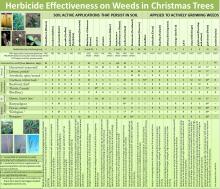In this section
Christmas Trees
Excessive weed growth in Christmas trees reduces tree vigor, increases vertebrate pests, and can reduce the quality of the product if plant debris is lodged among branches. However, completely eliminating all vegetation increases runoff, soil erosion, and soil compaction and can diminish tree quality if branches get muddy during harvest. Consequently, vegetation management in Christmas trees requires a balanced approach. Realizing that the goal is to produce quality trees while maintaining long-term site quality and managing—not just controlling—weeds.
Managing weedy vegetation Successful vegetation management in Christmas trees requires a comprehensive approach whereby a combination of weed control practices are used and alternated over several years. Developing these strategies requires knowledge of each weed and control practice. Identify weeds and gather information about the effectiveness of each weed control practice. Consider costs, and select herbicide combinations that can be applied together or in split applications that control the weeds in the crop without damage to trees. Note the action of each herbicide (how the chemical works in the plant), then tank mix and alternate use of these products to reduce the chance of developing resistant weeds. Often a combination of mechanical or herbicidal treatments, and sometimes hand removal or spot treatment with herbicide sprays or wipers, will provide the most effective year-round control.
Being a good neighbor Often, Christmas trees are grown with an assortment of other crops and nearby land uses ranging from apples to zucchini to organic farms to schools. It is important to be mindful of what is growing or happening near the farm. Wine grapes are sensitive to phenoxy herbicides (like 2,4-D and Garlon), especially during bloom and fruit set (March to June). Use the amine formulation, and remember that drift is illegal. Christmas trees have their own sensitivities, especially at bud break when new growth emerges.
Weed shifts Weed infestations are dynamic and change depending on new species introductions and previous cultural and weed control practices. For example, routine cultivation, mowing, or use of the same or similar herbicides will result in weed shifts to species that tolerate these practices. Examples include prostrate weeds that tolerate flailing, deep-rooted or easily spread perennials that tolerate cultivation, and weeds such as common groundsel, field bindweed, and false dandelion, that resist repeated applications of the same or similar herbicides.
Preventing weed shifts Weeds that survive cultivation, mowing or flailing, specific herbicide treatments, or other routine cultural practices must be eliminated before the tolerant species or biotypes become established. Combine a variety of weed control practices or treatments—rotate fields, cultural practices, and herbicides—and spot treat with a hoe or registered herbicide when the weed first appears. Also, clean equipment when moving from an infested field.
Herbicide resistance management Repeated use of glyphosate in perennial crops in western Oregon, including Christmas trees, has selected for a resistant biotype of annual ryegrass. Overreliance on herbicides with a single site of action increases the risk of selecting for resistance in other weed species, and threatens the long-term usefulness of glyphosate for weed control in orchards and other crops. Several alternative, nonselective herbicides, listed below, have different sites of action, and can be applied in rotation with glyphosate to reduce the risk of selecting for weeds that are resistant to glyphosate. Refer to “Section C. Agrichemicals and their Properties” and the subsection “Managing Herbicide-Resistant Weeds” in this handbook for more information.
Steps to avoid or manage glyphosate resistance:
- Use other means to manage weeds, such as cultivation and mowing.
- Use preemergence herbicides where possible. Consider use of other nonselective herbicides, such as glufosinate with PPO inhibitors for burndown control.
- To delay development of resistance, use higher glyphosate rate, and do not cut the rate.
- If using glyphosate in plantations with resistant weeds, tank mix glyphosate with other herbicides and make the application when the weeds are small.
- Do not let weeds go to seed.
Ground covers/mulches Some growers manage vegetation such as subclover, grass or weedy vegetation between rows to reduce soil erosion, improve traffic conditions in wet weather, and reduce mud on harvested trees. New grass varieties—including dwarf cultivars such as ‘Aurora Gold’ and ‘Soil Guard’, which respond well to drought, low soil fertility, or sublethal rates of post-emergence herbicides—are being introduced into various horticultural cropping systems. A number of other hard fescue varieties have worked well for Christmas tree growers. Mulches and barriers such as straw and straw bales, and/or course wood debris, can also help hold the soil in place. Consult your local Extension agent or get recent information about living mulches and their management.
Soil-active herbicides Persistent, soil-applied herbicides can be applied to weed-free soil during winter when rain will activate the chemical. Apply lower rates on sandy soils with lower clay, organic matter, or cation exchange capacities.
Post-emergence herbicides These are applied to weeds once they emerge, often at a specific weed growth stage, either as a directed spray away from the tree or over the trees in specific situations. For example, clopyralid (e.g., Stinger) may control selected thistles if applied at the proper weed growth stage and may be sprayed over the top of selected tree species. Glyphosate (e.g., Roundup) is typically applied as a directed spray and controls many weeds, but must be applied at the correct stage of weed growth to obtain maximum movement of the product into the roots (see label for details). Avoid applications to green bark, low limbs, or crop foliage. Three post-emergence grass herbicides (Segment, Fusilade, and Envoy Plus) can be applied to actively growing grasses in the four- to five-leaf stage for optimum results. More mature grasses can be controlled but often require two applications. All fine fescues resist these products.
Note Herbicides must be applied at the correct rate and time to selectively control weed growth with minimal chance of injury to trees. Obtain more consistent results by reading the herbicide label and other information about the proper application and timing of each herbicide. Good record keeping regarding plant growth stages, rates, surfactants, and weather will also help. Suggested rates listed in this guide are stated as pounds active ingredient per acre (lb ai/A) or pounds acid equivalent per acre (lb ae/A), as well as product amounts per acre.
Some products are not recommended for first-year seedlings and/or some stock-types, such as container seedlings, that may be more susceptible to damage using soil-active herbicides due to the light-textured potting mix.
Site Preparation Many new Christmas tree growers are so anxious to plant trees that they rush into planting before the site is well prepared or the weeds are under control. Most regret the rush. Prior to tree planting, there are a wide range of chemical and mechanical site preparation options. After planting, options are more limited because the trees require protection. Be aware, too, that even though the site may look clean, many brush species, such as blackberries, can rapidly sprout from living root systems. Again, better to wait a year and clean up your site than to rush into planting.



